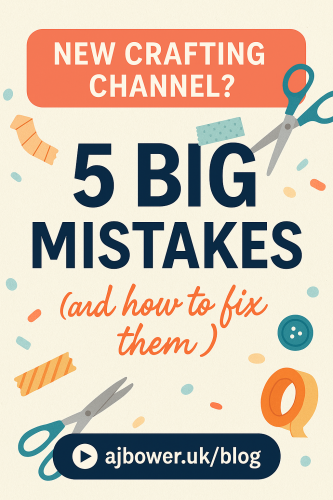5 Rookie Mistakes Crafting Channels Make (and How to Fix Them)
 Starting a crafting YouTube channel is so exciting. You finally get to share your ideas, your projects, and your love of crafting with the world. But let’s be honest — those first few videos can feel overwhelming. I was so nervous when starting that I’m embarrassed when I watch my early videos. However, we all have to start somewhere! I’m not saying I have ‘fixed’ all of these issues, but I am working on them. 🙂
Starting a crafting YouTube channel is so exciting. You finally get to share your ideas, your projects, and your love of crafting with the world. But let’s be honest — those first few videos can feel overwhelming. I was so nervous when starting that I’m embarrassed when I watch my early videos. However, we all have to start somewhere! I’m not saying I have ‘fixed’ all of these issues, but I am working on them. 🙂
The truth is, most of us make the same mistakes when we begin. The good news? They’re easy to fix once you know what to look out for.
Here are five of the most common rookie errors crafting creators make — and how you can avoid them.
1. Long, Chatty Intros
The mistake: Many new creators start their videos with a long hello, a backstory about their day, or a deep dive into supplies before the crafting even begins. The problem? Viewers often click away in the first 30 seconds if they’re not hooked.
The fix: Keep it short and sweet. A friendly hello and a simple line like “Today I’ll show you how to make a faux shutter card” is plenty. Viewers clicked for the craft — not a ten-minute life update about your cat (as cute as she is). You can sprinkle in personality once the tutorial is underway.
I’ve tried intros and immediate starts and the quick beginnings seem to have a much better retention rate. I’m still experimenting at this time. 🙂
2. Poor Camera Angles
The mistake: Nothing is more frustrating than not being able to see what’s happening. Hands blocking the view, wobbly footage, or filming from the wrong angle can make even the best tutorial unwatchable. I’ve been off-camera myself a few times when I’ve not been taking notice and know how this can irritate!
The fix: An overhead shot works best for most crafts. You don’t need expensive equipment — a phone on a tripod, stand, or even a DIY setup (think: a stack of books and a bit of tape or a high-ish shelf) can work until you can afford something better.
💡 Pro tip: Use a casting or screen-mirroring app (or your camera’s companion app if it has one) so you can check on another device what your camera sees. It’s like having a tiny director on set making sure you’re in shot — minus the megaphone. I’ve used both AirDroid Cast and LetsView, both work really well.
3. Bad Lighting & Audio
The mistake: Dark, shadowy footage and muffled sound can turn viewers off instantly. Even if your craft is amazing, poor quality makes it hard to follow. I film a lot of videos late afternoon or evening and you can really tell the difference in the picture quality.
I watch a very talented crafter, but her videos are normally filmed in 360p resolution and this makes it difficult to see details. You should aim for 720p at the absolute minimum. People will click away if your video is of a poor resolution. Most modern devices have a very good HD resolution when filming, so make use of it. I often split my long video recordings into segments as I go so my phone doesn’t fill up with huge video files. I then upload them to my cloud service before downloading them to my PC to import into my video editor. Then I delete them from my phone and cloud service to clear up space.
The fix: Natural daylight is your best friend. Set up near a window or add a daylight bulb to a desk lamp. For sound, film in a quiet room and speak clearly. Most phone mics are surprisingly good, but if you want to upgrade, a budget clip-on microphone can make a big difference for under £20. I use this overhead phone mount with ring light.
Think of it this way: if your viewers can’t see your craft, they’ll think you’re hiding some kind of top-secret glue technique. And if they can’t hear you, they’ll assume you’re whispering your wisdom only to the cat!
4. Over-Editing (or No Editing at All)
The mistake: Some beginners upload videos with every pause, mistake, and bouts of silence left in. Others go the opposite way, adding loud music, flashy transitions, and effects that look like they belong in a sci-fi movie. I try really hard to cut out ‘dead’ space, ums and errs, coughs and throat clearing, but it’s not practical in every instance. I always speed up where I can and people seem to appreciate it. If you are new to video creation, I get it, video editing can seem very daunting, but just knowing how to trim, cut and speed up are really all you need to know. Canva has a free video editor that’s easy to use…relatively.
The fix: Keep editing simple and focused on clarity. Trim away dead time, speed up repetitive steps, and add a bit of text overlay or voiceover if needed. Free software like DaVinci Resolve or Shotcut works brilliantly for beginners. For a more professional software I recommend Cyberlink Power Director.
Remember: viewers came for card folds, not a Michael Bay explosion sequence.
5. Forgetting About the Viewer
The mistake: It’s easy to get caught up talking about your tools, your workspace, or why you wanted to try a project. The danger? Viewers may feel left out if the focus isn’t on them.
The fix: Always frame your video around the benefit to the viewer. Instead of saying “I just wanted to use up some scraps,” try “This fold is perfect for using up scraps — here’s how you can do it too.” I’m still working on this. 🙂
Think of your video like inviting someone into your craft room: they came to learn, not to watch you hunt for scissors under a pile of paper (though, let’s be honest, we’ve all been there). It’s also a good idea to not have a cluttered workspace in view as that may distract and put off the viewer. It doesn’t matter what the rest of the room is like, but your on-camera shot should be pristine where possible. 🙂
Final Thoughts
Every creator makes mistakes at the start — that’s part of the fun (and the learning!). The key is to improve a little with each video. If you focus on clear tutorials, simple editing, and making your viewers feel included, your channel will naturally grow.
